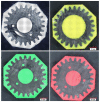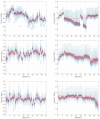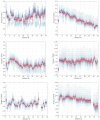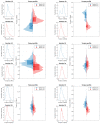Wear Analysis of 3D-Printed Spur and Herringbone Gears Used in Automated Retail Kiosks Based on Computer Vision and Statistical Methods
- PMID: 37629844
- PMCID: PMC10456592
- DOI: 10.3390/ma16165554
Wear Analysis of 3D-Printed Spur and Herringbone Gears Used in Automated Retail Kiosks Based on Computer Vision and Statistical Methods
Abstract
This paper focuses on a wear evaluation conducted for prototype spur and herringbone gears made from PET-G filament using additive manufacturing. The main objective of this study is to verify if 3D-printed gears can be considered a reliable choice for long-term exploitation in selected mechanical systems, specifically automated retail kiosks. For this reason, two methods were applied, utilizing: (1) vision-based inspection of the gears' cross-sectional geometry and (2) the statistical characterization of the selected kinematic parameters and torques generated by drives. The former method involves destructive testing and allows for identification of the gears' operation-induced geometric shape evolution, whereas the latter method focuses on searching for nondestructive kinematic and torque-based indicators, which allow tracking of the wear. The novel contribution presented in this paper is the conceptual and experimental application of the identification of the changes of 3D-printed parts' geometric properties resulting from wear. The inspected exploited and non-exploited 3D-printed parts underwent encasing in resin and a curing process, followed by cutting in a specific plane to reveal the desired shapes, before finally being subjected to a vision-based geometric characterization. The authors have experimentally demonstrated, in real industrial conditions, on batch production parts, the usefulness of the presented destructive testing technique providing valid indices for wear identification.
Keywords: 3D printing; additive manufacturing; automated retail kiosk; computer vision; epoxy resin encase; fused deposition modeling (FDM); fused filament fabrication (FFF); gears; material extrusion (MEX); statistical methods; wear.
Conflict of interest statement
The authors declare no conflict of interest. The funders had no role in the design of the study; in the collection, analyses, or interpretation of data; in the writing of the manuscript; or in the decision to publish the results.
Figures






















References
-
- Wohlers T.T., Campbell I., Diegel O., Huff R., Kowen J. Wohlers Report 2020—3D Printing and Additive Manufacturing Global State of the Industry. Wohlers Associates; Fort Collins, CO, USA: 2018.
-
- Bonaiti L., Concli F., Gorla C., Rosa F. Bending fatigue behavior of 17-4 PH gears produced via selective laser melting. Procedia Struct. Integr. 2019;24:764–774. doi: 10.1016/j.prostr.2020.02.068. - DOI
Grants and funding
LinkOut - more resources
Full Text Sources

